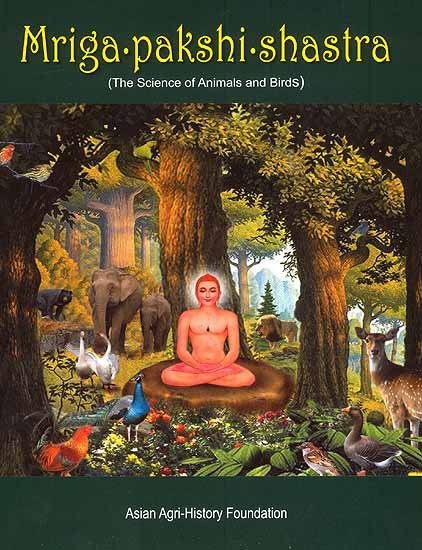Animal Kingdom (Tiryak) in Epics
by Saranya P.S | 2019 | 51,616 words | ISBN-10: 8190396315 | ISBN-13: 9788190396318
An English study the Animal Kingdom (Tiryak) in Epics.—The present thesis is based entirely on Ramayana and Mahabharata although an attempt is made to analytically compare the Animal kingdom with Mriga-pakshi-shastra—‘The ancient Indian science of of Animals and Birds’....
Chapter 4.31 - The Mayura (Peacock) in the Epics
The bird Mayura has been known since the Vedic times and has adorned flags, thrones and crowns. It has great symbolic meaning in the Indian culture. In Sanskrit literature, the lavish beauty of the mayuras is described. The plumage and the calls of Mayuras are said to be adding to the exquisite lush green forests and there is great appreciation of how the peacocks welcome the rains. Right from the epics, there have many references to these birds.
In the Ramayana, Bharata says, “Behold these mayuras which we are so delighted to look at. But they are greatly frightened by the sight of the army. Then they hasten towards the mountains, the abode of birds.
The mountains and the and the forests are said to be resounding with the calls of the mayuras.
“You will see springs on mountains charming to the eye and beautiful forests resounding with the noise of mayuras.”[1]
“Here are seen lofty and charming mountains made noisy by mayuras. These mountains have many caves and are covered with trees in blossom.”[2]
In the Mahabharata, the mayura is described as bhujagasana which means one that devours snakes. Here it is said: “Be always guarded by speech or sacred text like the peacock remains silent in the season of Sarat, autumn.
In the Uttarakanda of Ramayana, once Ravana set out with his army of demons to gain victory over kings. At that time gods disguised in different attire fled away in panic. At that time Indra assumed the form of a peacock.[3] Indra gives mayura many boons.
In many places in the Ramayana we can see descriptions about the peacock.
There are 6 varieties of peacocks[4]. They have blue, green and red colours on their bodies. Their necks are greenish blue. They have big crests on their tails. The crests are made of feathers of different colours. They are fond of dancing in different modes. Peacocks with crowns on their heads are males. They dance when they see clouds. They eat grains, fruits and insects. They dwell on the branches of trees. They are cowardly. They mate in the spring and summer seasons. Their prime of you is when they are 11 years old.
The 1st variety of peacocks is Mayura. They are green in colour. They are tall and have long necks and legs. They often make sounds and they fly in different ways. They dance more in the evenings. They are not gluttons. They are generally calm. The noise of thunder delights them.
The 2nd variety is called Barhi. They are very tall and have broad crests. There are different varieties of spots on their bodies. They walk fast. They have small beaks but long legs. They like to eat a lot. They dance in the mornings and evenings in various modes. They never wander in the hot sun. They like shades. They can be easily captured and trained.
The 3rd variety is Nilakantha. They are called so because they have blue necks, whereas their body is green. They are short in size and their legs are also short. They are fond of jumping up and down in different modes. In the rainy season they dance in various ways. They sleep very little in the night. Their cry is pleasant. They have beautiful eyes, crests and necks. From their bodies a good odour is emitted. They are fond of sporting in water in summer.
The 4th variety is called Bhujangabhuk. They eat serpents and that is why they are called bhujangabhuk. Their bodies are small. They live in forests. They often cry in the mornings. Their eyes become red when angry. They usually dwell on trees. They are fond of eating flesh. Their feathers are rough. They do not like the scent of human beings. They have lean bodies and lean wings. They do dance well. Sometimes a bad odour comes out of their bodies. They are not good to be tamed.
The 5th variety is known as Shikhavala. They are short. They have marks of different colours on their bodies. They have very long necks and long beaks. They like to wander all the time. They dance well. They are fond of going out in the evenings. They eat fruits, grain and flesh. They are easily captured and trained.
The 6thvariety is called Kekin. They are called so because when they sit still or when they wander they produce the sound 'Ke-Ka'. They are tall. They like to wander in streets. They have very smooth bodies. When they are young they dance a lot. The hot sun tires them and they like to remain in the shores near water bodies. They have red eyes and feet. Their walk is very elegant. They have beautiful wings. Their crests resemble the rainbow colours. Their life span is 6 years.
Footnotes and references:
[1]:
Valmiki Ramayana .III.14.14
[2]:
Mahabharata .12.120.7a
[3]:
Valmiki Ramayana .VII.18.5
[4]:
Mrigapakshishastra [mriga-pakshi-shastra] .II.30.452
